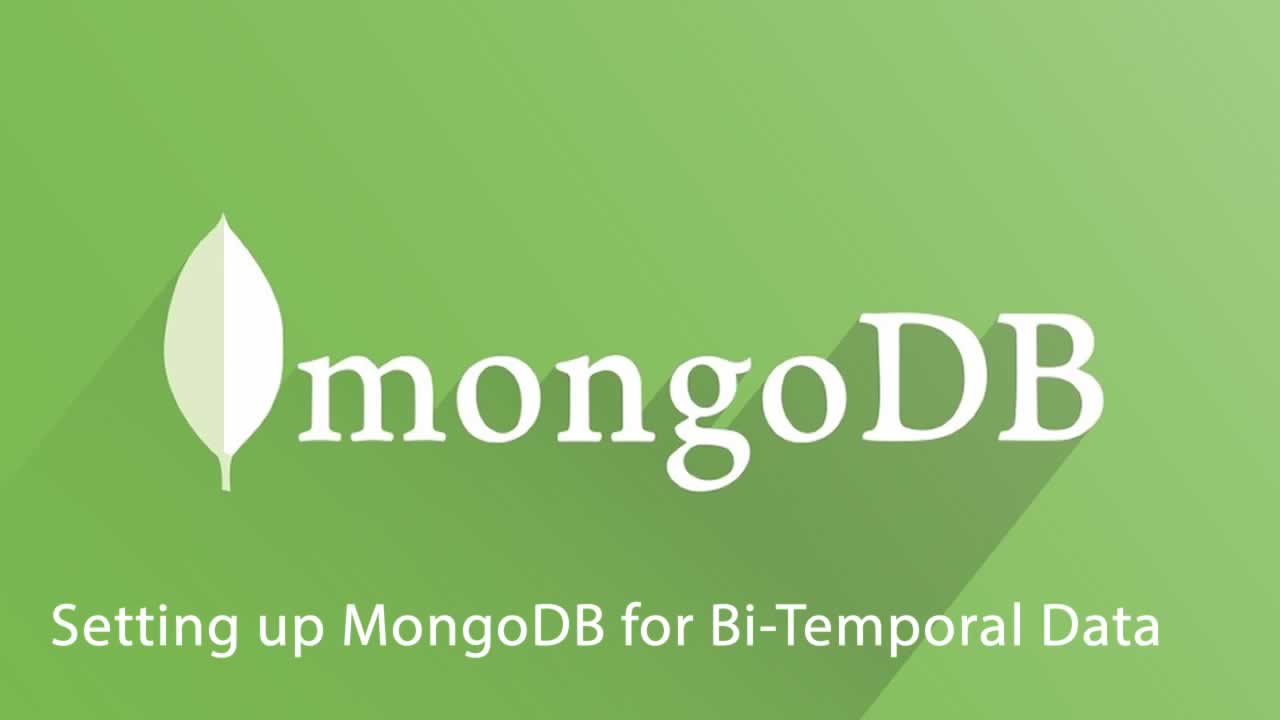Setting up MongoDB for Bi-Temporal Data
In this tutorial, I will demonstrate how to integrate BarbelHisto with MongoDB to have a properly audit-proof document management solution.
1. Get Your Version of BarbelHisto
If you want to make MongoDB work with BarbelHisto, you need two maven dependencies to get started.
2. Develop a **Client** Pojo
Implement a POJO like this one:
public class Client {
@DocumentId
private String clientId;
private String title;
private String name;
private String firstname;
private String address;
private String email;
private LocalDate dateOfBirth;
}
Notice that we use the @DocumentIdannotation to tell BarbelHisto that the clientId uniquely identifies the client, and this should be the document id. BarbelHisto will maintain document journals for each document id.
3. Create an Instance of **BarbelHisto** With MongoDB Listeners
Like so:
MongoClient mongoClient = SimpleMongoListenerClient.create("mongodb://localhost:12345").getMongoClient();
// update listener
SimpleMongoUpdateListener updateListener = SimpleMongoUpdateListener.create(mongoClient, "testDb", "testCol", Client.class, BarbelHistoContext.getDefaultGson());
// pre-fetch listener
SimpleMongoLazyLoadingListener loadingListener = SimpleMongoLazyLoadingListener.create(mongoClient, "testDb", "testCol", Client.class, BarbelHistoContext.getDefaultGson());
// locking listener
MongoPessimisticLockingListener lockingListener = MongoPessimisticLockingListener.create(mongoClient, "lockDb", "docLocks");
// BarbelHisto instance
BarbelHisto<Client> mongoBackedHisto = BarbelHistoBuilder.barbel().withSynchronousEventListener(updateListener)
.withSynchronousEventListener(loadingListener).withSynchronousEventListener(lockingListener).build();
You can use your own MongoClient settings if you like. The BarbelHisto mongo package does provide a client creation class for convenience. There are three listeners registered synchronously with BarbelHisto. The SimpleMongoUpdateListener will forward updates saved against BarbelHisto against the mongo shadow collection. The SimpleMongoLazyLoadingListener listener ensures that data is fetched into the local BarbelHisto instance if clients perform queries using the BarbelHisto.retrieve() methods. The MongoPessimisticLockingListener will lock journals in mongo if the client performs an update using the BarbelHisto.save().
4. Do Some Bi-Temporal **save()** Operations
With this setup, you can now store and retrieve bi-temporal data with a MongoCollection as a remote data source.
Client client = new Client("1234", "Mr.", "Smith", "Martin", "some street 11", "somemail@projectbarbel.org", LocalDate.of(1973, 6, 20));
mongoBackedHisto.save(client, LocalDate.now(), LocalDate.MAX);
5. Retrieve Bi-Temporal Data From MongoDB
Later, in other sessions of your web application, you can retrieve the client using the BarbelHisto.retrieve() from MongoDB.
Client client = mongoBackedHisto.retrieveOne(BarbelQueries.effectiveNow("1234"));
Use the BarbelQueries to make queries against the MongoDB backed BarbelHisto instance. You can also combine BarbelQueries.
List<Client> clients = mongoBackedHisto.retrieve(QueryFactory.and(BarbelQueries.effectiveNow("1234"),BarbelQueries.effectiveNow("1234")));
Be careful if you don’t specify document IDs in your query. This might cause a full load of the mongo collection.
That’s it. There is nothing more to do than this.
Let’s access the version data for the client object we’ve just added. You’ve retrieved the client previously in this tutorial. You can cast every object received from BarbelHisto to Bitemporal to access the version data.
Bitemporal clientBitemporal = (Bitemporal)client;
System.out.println(clientBitemporal.getBitemporalStamp().toString());
If you’d like to print out what MongoDB knows about your client, then pretty print the document journal like so:
System.out.println(mongoBackedHisto.prettyPrintJournal("1234"));
This should return a printout that looks similar to this one:
Document-ID: 1234
|Version-ID |Effective-From |Effective-Until |State |Created-By |Created-At |Inactivated-By |Inactivated-At |Data |
|----------------------------------------|---------------|----------------|--------|---------------------|---------------------------------------------|---------------------|---------------------------------------------|-------------------------------|
|d18cd394-aa62-429b-a23d-46e935f80e71 |2019-03-01 |999999999-12-31 |ACTIVE |SYSTEM |2019-03-01T10:46:27.236+01:00[Europe/Berlin] |NOBODY |2199-12-31T23:59:00Z |EffectivePeriod [from=2019-03- |
You can get the complete code from this tutorial in this test case.
Configuring for Performance
In the previous paragraphs, I’ve used the lazy loading and update listeners to integrate a MongoCollection with the synchronous event bus. There are advantages and some drawbacks of this configuration, especially in scenarios where high performance is one of the key requirements.
Registration with the synchronous service bus eases error handling because clients can react immediately when an exception is thrown in the listeners. On the other hand, synchronous means waiting(!) for a response, which isn’t always necessary, especially with update operations.
Also, the lazy loading listeners require the user to pass the journal ID in queries to work properly. In some situations, this isn’t enough. Clients may want to define complex custom queries against BarbelHisto, which combine many attributes, but no document IDs are included. In fact, these complex queries should have the document IDs as a result, not as a parameter. For instance, when an address or client name is known and the user needs to find the corresponding client record or a policy number (which is the document ID in many cases).
To address the complex query and performance requirements, users can configure BarbelHisto in advanced performance setups. One option is that you can resign lazy loading listeners. Instead, you use disk persistent indexed collections as object query pool. At the same time, you register a SimpleMongoUpdateListener to the asynchronous service bus. In such a setup, complex queries can be defined without restrictions and the data is still shadowed to a MongoCollection of your choice. But everything works considerably faster than in the synchronous scenarios described above.
// define primary key in POJO class -> versionID !
SimpleAttribute<Client, String> primaryKey =
new SimpleAttribute<Client, String>("versionId")
{
public String getValue(Client object, QueryOptions queryOptions) {
return (String) ((Bitemporal) object).getBitemporalStamp().getVersionId();
};
// define the update listener
SimpleMongoUpdateListener updateListener = SimpleMongoUpdateListener.create(client.getMongoClient(),
"testSuiteDb", "testCol", Client.class, BarbelHistoContext.getDefaultGson());
// make BarbelHisto backbone persistent and register
// Mongo update listener with asynchronous bus
BarbelHisto<DefaultPojo> histo = BarbelHistoBuilder.barbel()
.withBackboneSupplier(() -> new ConcurrentIndexedCollection<>
(
DiskPersistence.onPrimaryKeyInFile(primaryKey, new File("test.dat"))
)
).withAsynchronousEventListener(updateListener);
In the first step, you define the primaryKey, which is mandatory when you use persistent disk space. Use the versionId as the primary key as demonstrated above. Then, define the update listener and register that with BarbelHistoBuilder. Also, register a DiskPersistence backbone using the builder. In the above example, your data is kept in the test.dat file and also in the shadow MongoCollection.
Look into this test case to see the complete scenario, and let us know your thoughts and questions in the comments below.
Learn More
☞ Fullstack Vue App with Node, Express and MongoDB
☞ Building A REST API With MongoDB, Mongoose, And Node.js
☞ AngularJS tutorial for beginners with NodeJS, ExpressJS and MongoDB
☞ Creating RESTful APIs with NodeJS and MongoDB Tutorial
☞ MongoDB with Python Crash Course - Tutorial for Beginners
☞ MongoDB - The Complete Developer’s Guide
☞ The Complete Developers Guide to MongoDB
☞ MongoDB - The Complete Developer’s Guide
☞ Learn MongoDB : Leading NoSQL Database from scratch
☞ Learn NoSQL Databases - Complete MongoDB Bootcamp 2019
#mongodb #database
